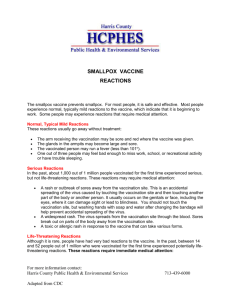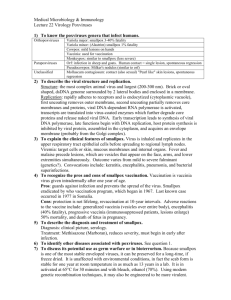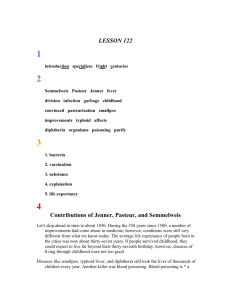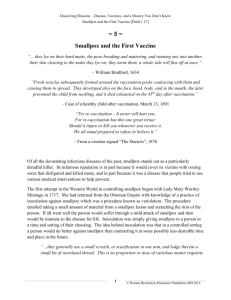A short history of Smallpox Vaccine
advertisement
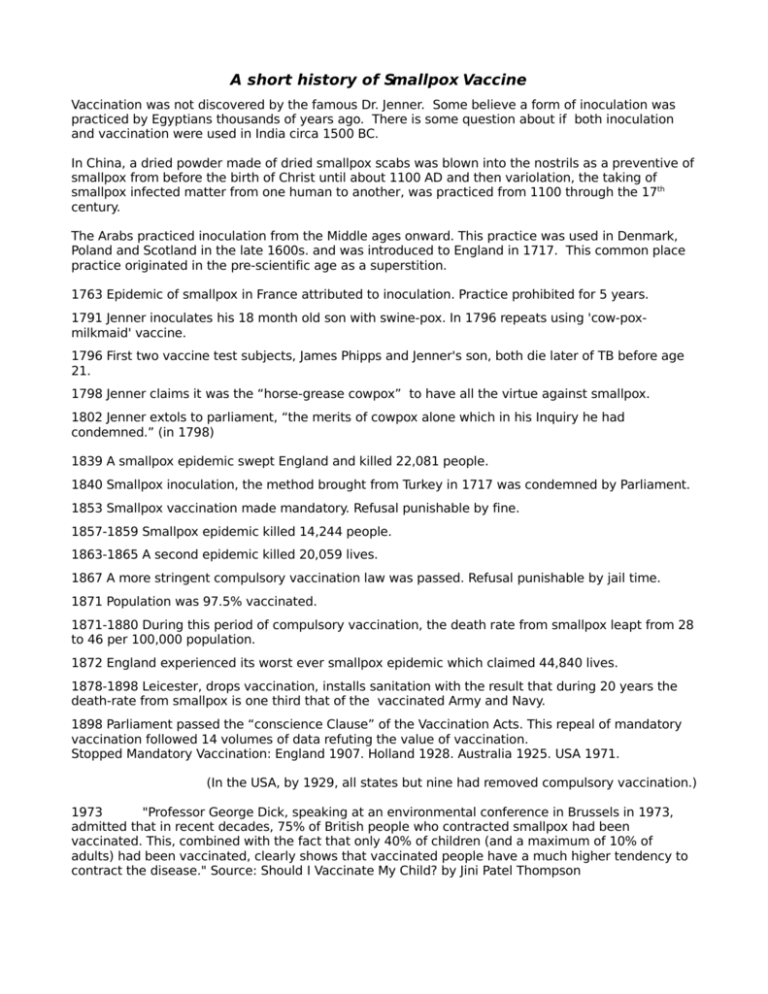
A short history of Smallpox Vaccine Vaccination was not discovered by the famous Dr. Jenner. Some believe a form of inoculation was practiced by Egyptians thousands of years ago. There is some question about if both inoculation and vaccination were used in India circa 1500 BC. In China, a dried powder made of dried smallpox scabs was blown into the nostrils as a preventive of smallpox from before the birth of Christ until about 1100 AD and then variolation, the taking of smallpox infected matter from one human to another, was practiced from 1100 through the 17th century. The Arabs practiced inoculation from the Middle ages onward. This practice was used in Denmark, Poland and Scotland in the late 1600s. and was introduced to England in 1717. This common place practice originated in the pre-scientific age as a superstition. 1763 Epidemic of smallpox in France attributed to inoculation. Practice prohibited for 5 years. 1791 Jenner inoculates his 18 month old son with swine-pox. In 1796 repeats using 'cow-poxmilkmaid' vaccine. 1796 First two vaccine test subjects, James Phipps and Jenner's son, both die later of TB before age 21. 1798 Jenner claims it was the “horse-grease cowpox” to have all the virtue against smallpox. 1802 Jenner extols to parliament, “the merits of cowpox alone which in his Inquiry he had condemned.” (in 1798) 1839 A smallpox epidemic swept England and killed 22,081 people. 1840 Smallpox inoculation, the method brought from Turkey in 1717 was condemned by Parliament. 1853 Smallpox vaccination made mandatory. Refusal punishable by fine. 1857-1859 Smallpox epidemic killed 14,244 people. 1863-1865 A second epidemic killed 20,059 lives. 1867 A more stringent compulsory vaccination law was passed. Refusal punishable by jail time. 1871 Population was 97.5% vaccinated. 1871-1880 During this period of compulsory vaccination, the death rate from smallpox leapt from 28 to 46 per 100,000 population. 1872 England experienced its worst ever smallpox epidemic which claimed 44,840 lives. 1878-1898 Leicester, drops vaccination, installs sanitation with the result that during 20 years the death-rate from smallpox is one third that of the vaccinated Army and Navy. 1898 Parliament passed the “conscience Clause” of the Vaccination Acts. This repeal of mandatory vaccination followed 14 volumes of data refuting the value of vaccination. Stopped Mandatory Vaccination: England 1907. Holland 1928. Australia 1925. USA 1971. (In the USA, by 1929, all states but nine had removed compulsory vaccination.) 1973 "Professor George Dick, speaking at an environmental conference in Brussels in 1973, admitted that in recent decades, 75% of British people who contracted smallpox had been vaccinated. This, combined with the fact that only 40% of children (and a maximum of 10% of adults) had been vaccinated, clearly shows that vaccinated people have a much higher tendency to contract the disease." Source: Should I Vaccinate My Child? by Jini Patel Thompson London, England Note: smallpox decline prior to introduction of vaccination. Note: decline of death from all causes prior to 1800. Was this general decline, and the specific decline in smallpox due to sanitary reforms begun in the mid 1700's, or the practice of variolation? (the inoculation of human pus from smallpox sufferers into other humans.) This question must be given a good answer. More information is first required. http://www.wku.edu/%7Esmithch/wallace/S616.htm A Summary of the Proofs That Vaccination Does Not Prevent Small-pox but Really Increases It (S616: 1904) [Doctors are not the best judges of the results of vaccination. (Incorrect training & financial bias.) Statisticians require the best statistics, over wide areas, large populations, long times and with a comparison of vaccinated to unvaccinated. Diseases have cycles, overall death rates are a good indication of progress.] V. Thirty Years of Rapidly Decreasing Vaccination in Leicester, and its Teachings. (1) The great manufacturing town of Leicester, with nearly 200,000 inhabitants, affords the most conclusive proof of the uselessness of vaccination that it is possible to have; and the doctors and government officials carefully avoid dealing with it except to prophecy evils which have never come to pass. Down to 1872 Leicester was one of the most completely vaccinated towns in the kingdom, the number of vaccinations, owing to alarm after epidemics, several times exceeding the number of births. Yet in 1871, at the very height of its good vaccination record, it was attacked by the epidemic with extreme severity, its small-pox deaths during that year being more than 3,500 per million of the population, or about a thousand per million more than the mortality in London during the same epidemic. If ever a test experiment existed it is this of Leicester, where an almost completely vaccinated community suffered more than unvaccinated and terribly insanitary London, on the average of the last forty years of the eighteenth century. But even more conclusive evidence is to come. (2) That fearful mortality destroyed the faith of Leicester in vaccination. Poor and rich alike, the workers and even the municipal authorities began to refuse vaccination for their children. This refusal continued till, in 1890, instead of 95 per cent. the vaccinations reached only 5 per cent. of the births! [[p. 17]] As this ominous decrease of vaccination went on the doctors again and again prophesied against it, that once small-pox was introduced it would run through the town like wildfire and decimate the population. Yet it has been introduced again and again, but it has never spread; and from that day to this no town in the kingdom of approximately equal population has had such a very low small-pox mortality as this almost completely unvaccinated and--as the doctors say-unprotected population! Surely this completes the demonstration that vaccination, instead of preventing, increases the liability to small-pox, and that the only way to abolish the disease is to do as Leicester did, leave off vaccination altogether and devote our energies to sanitation, and the isolation of such rare cases as do occur. Germany: 1870-1871 of these had been vaccinated. Over 1,000,000 people had smallpox of which 120,000 died. 96% Philippines: 1918-1919 Smallpox epidemic resulted in 60,855 deaths. (2) with over 95% of the population vaccinated, the worst epidemic in the Philippine's history occurred resulting in a case mortality of 65%. The highest percentage occurred in the capital Manila, the most thoroughly vaccinated place. The lowest percentage occurred in Mindanao, the least vaccinated place owing to religious prejudices. (2) Scotland: 1855-1875 over 9,000 children under 5 died of smallpox despite Scotland being, at that time, one of the most vaccinated countries in the world. 1907-1919 with only a third of the children vaccinated, only 7 smallpox deaths were recorded for children under 5 years of age. Below is pictured a table, capable of being tilted into either horizonal or vertical positions. A calf would be strapped to the table, and when the calf become horizonal, its belly would be shaved. A young calf would receive 30-50 three inch long deep scratches or cuts, while a young cow would endure 100-150 such three inch long cuts would be made in its belly. Into these cuts would be rubbed some lymph or pus from a human suffering from small pox. The calf or young cow would then be confined in a stall in which its head was confined so that it could not lick its wounds. After a week, the vaccinator would return with a special pliers to harvest a combination of blood watered down with lymph. Some pus, a few hairs and scabs were also harvested. The hair and scabs were then filtered out with a fine bronze screen. The resultant “pure” blood/lymph mixture would then be stabilized with glycerin. Later polymyxcin B sulfate, streptomycin sulfate, chlortetracycline hydrochloride, and neomycin sulfate were added.
